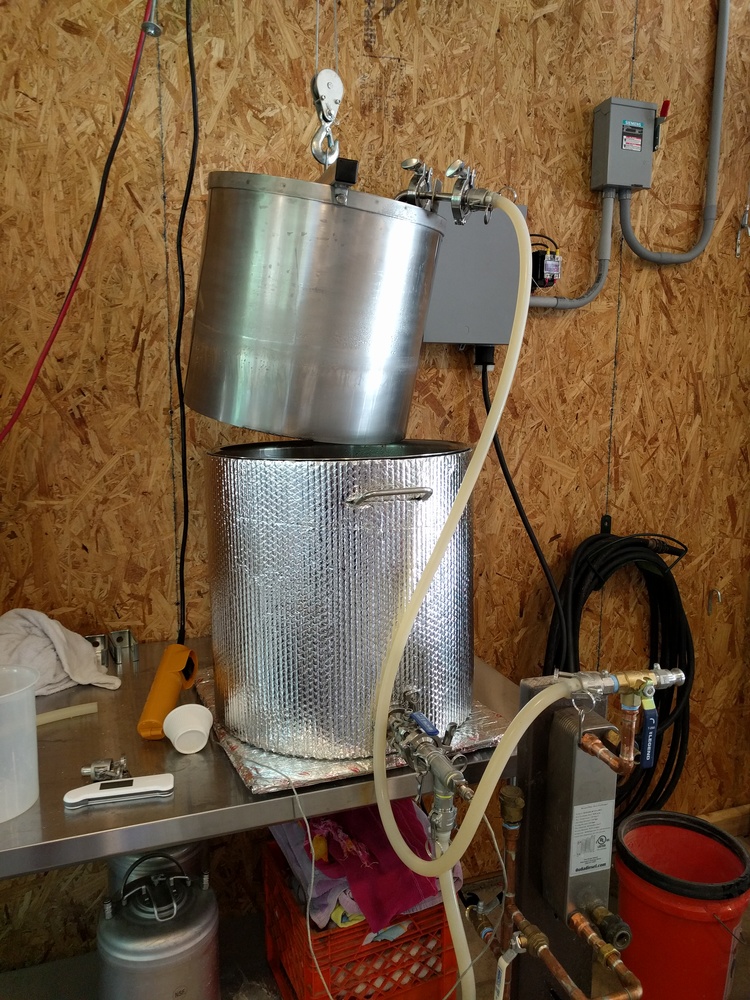SlitheryDee
General Manager
So I had my first BIAB experience last weekend. Everything went pretty smoothly, but I had a question.
The recipe called for a 90 minute mash, so I knew I'd lose a lot of heat during the course of it. With that in mind, I put my grains in when the water was a couple of degrees above what beersmith recommended. That resulted in my initial temperature being 154F, which felt good to me as it would allow the mash to spend most of it's time in the 145-152 degree range as the temps fell.
The insulation I was using proved kind of insufficient for the task, and I found myself firing up the burner twice during the course of the mash to keep the temperature comfortably above 143. The temperature never got away from me like I feared it might, but I still wondered what was happening to my enzymes near the bottom of the kettle where the heat source was. I stirred it constantly while applying heat, and stopped the flame well before the temperature rose to 150, which seemed to work as it would continue to climb a couple of degrees even after I killed the flame. In that way I managed to keep the mash in my target range for the whole 90 minutes.
Everything seems ok so far, but I'm wondering what the swings in temperature might have done to my wort. I'm also wondering if there is any negative effect to doughing in at a slightly high temperature like I did when the mash ended up spending most of it's time in the correct temperature range.
FWIW my OG ended up 4 points higher than I predicted, for an overall brewhouse efficiency of 74.9%. Doesn't seem too bad for a first try, but now I'm wondering what to do with that information. Should I assume ~75% efficiency from now on in order to more precisely dial in my ingredient amounts in the future? Should I give it a few more batches first?
The recipe called for a 90 minute mash, so I knew I'd lose a lot of heat during the course of it. With that in mind, I put my grains in when the water was a couple of degrees above what beersmith recommended. That resulted in my initial temperature being 154F, which felt good to me as it would allow the mash to spend most of it's time in the 145-152 degree range as the temps fell.
The insulation I was using proved kind of insufficient for the task, and I found myself firing up the burner twice during the course of the mash to keep the temperature comfortably above 143. The temperature never got away from me like I feared it might, but I still wondered what was happening to my enzymes near the bottom of the kettle where the heat source was. I stirred it constantly while applying heat, and stopped the flame well before the temperature rose to 150, which seemed to work as it would continue to climb a couple of degrees even after I killed the flame. In that way I managed to keep the mash in my target range for the whole 90 minutes.
Everything seems ok so far, but I'm wondering what the swings in temperature might have done to my wort. I'm also wondering if there is any negative effect to doughing in at a slightly high temperature like I did when the mash ended up spending most of it's time in the correct temperature range.
FWIW my OG ended up 4 points higher than I predicted, for an overall brewhouse efficiency of 74.9%. Doesn't seem too bad for a first try, but now I'm wondering what to do with that information. Should I assume ~75% efficiency from now on in order to more precisely dial in my ingredient amounts in the future? Should I give it a few more batches first?




![Craft A Brew - Safale BE-256 Yeast - Fermentis - Belgian Ale Dry Yeast - For Belgian & Strong Ales - Ingredients for Home Brewing - Beer Making Supplies - [3 Pack]](https://m.media-amazon.com/images/I/51bcKEwQmWL._SL500_.jpg)























































